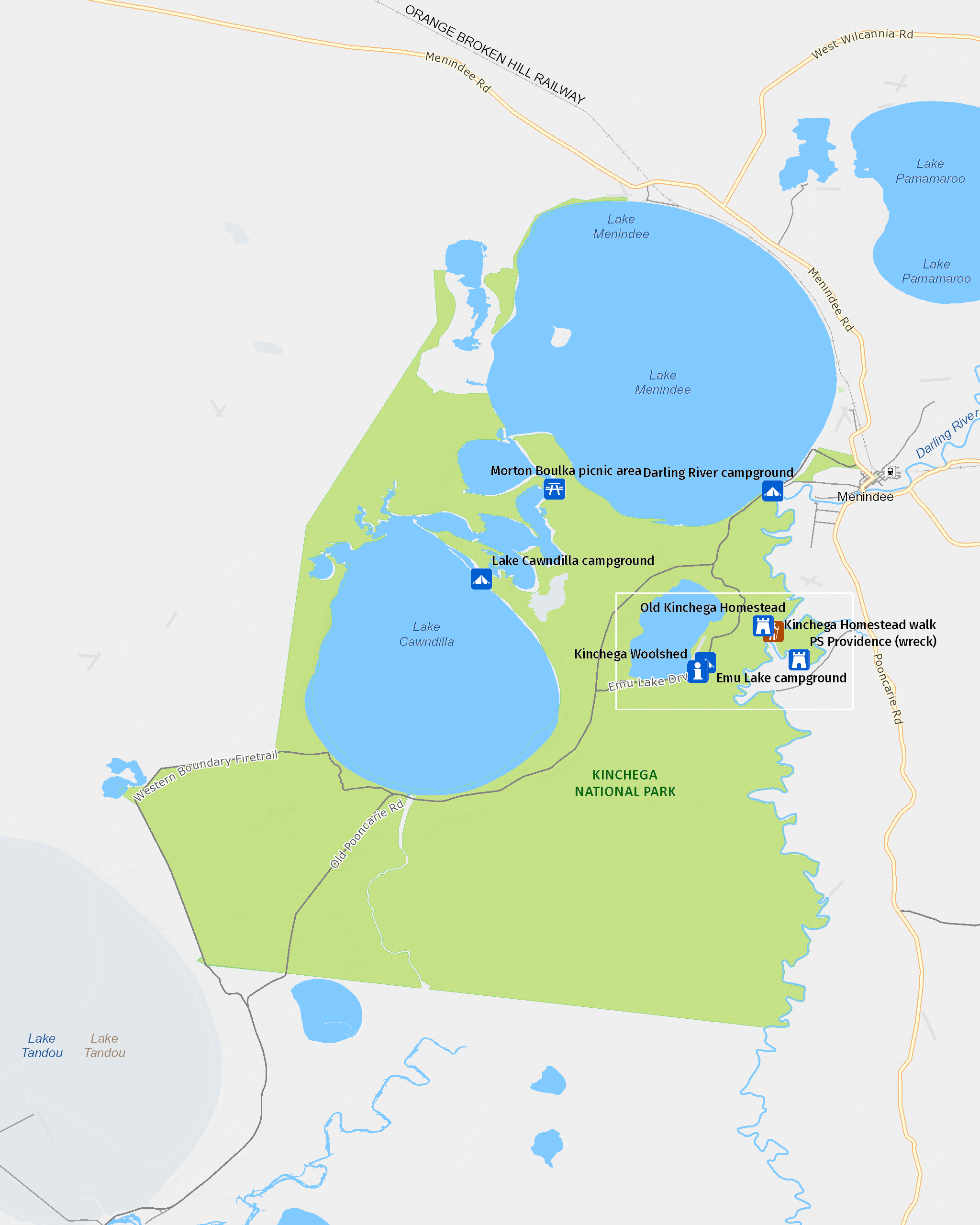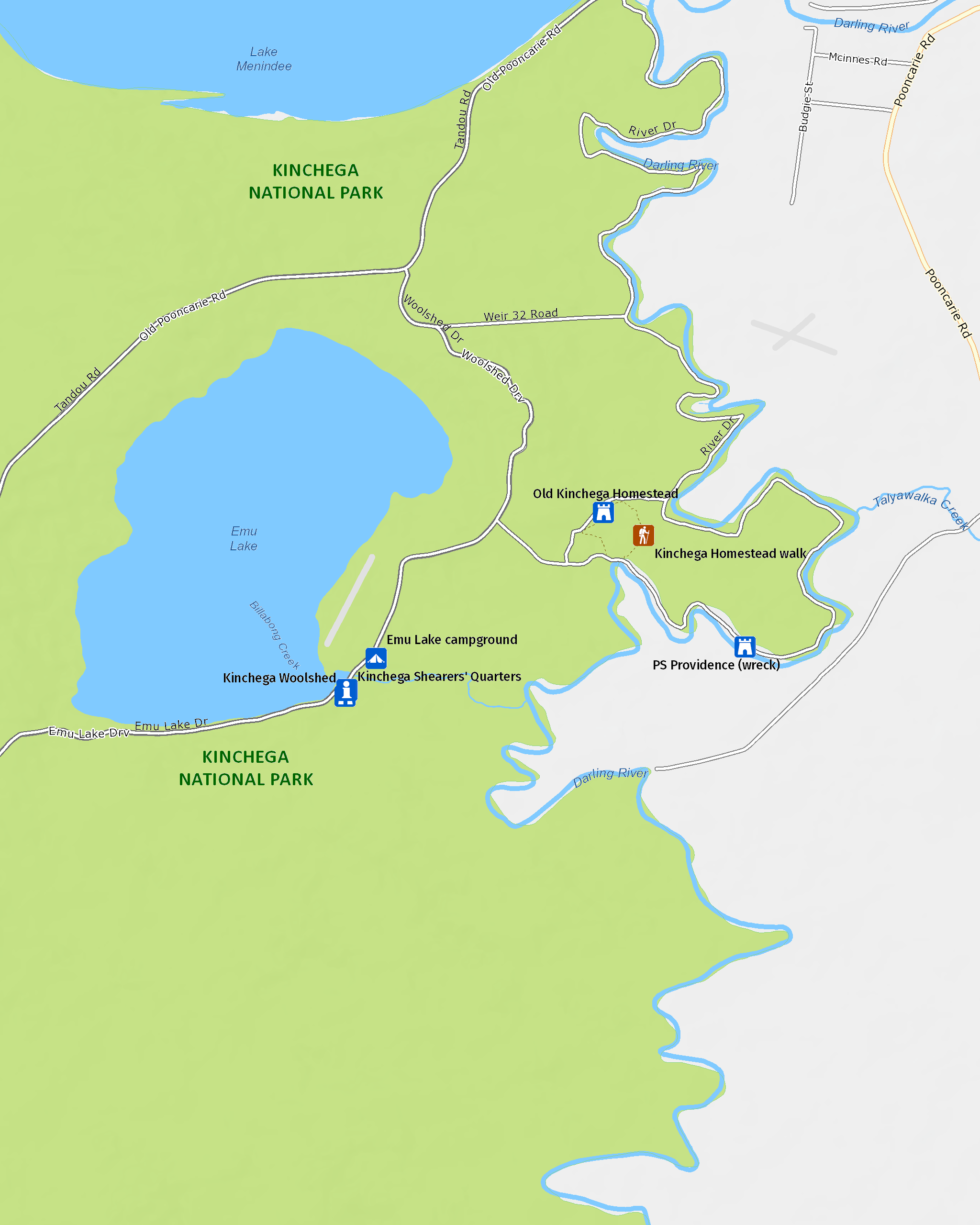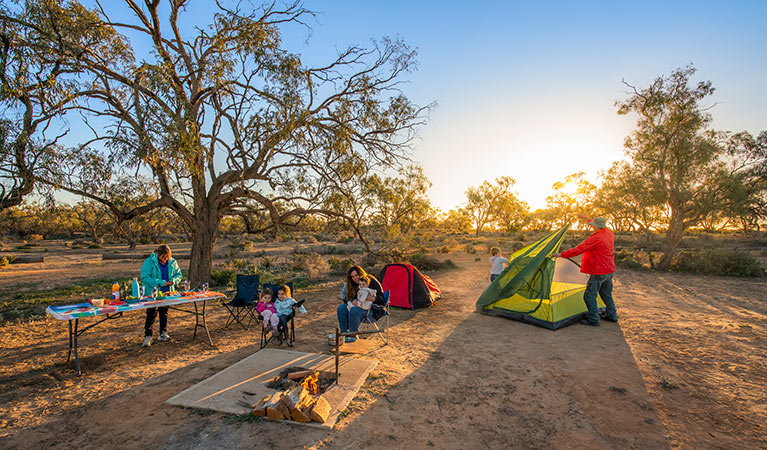Kinchega National Park
Overview
Camp beside the Darling River among the majestic river red gums of Kinchega National Park. Explore Aboriginal and pastoral history on a school excursion and marvel at the range of birdlife.
Read more about Kinchega National Park
Featuring the mesmerising Menindee lake system with its wonderful array of birdlife and haunting river red gums rising from the water, Kinchega National Park offers visitors a unique experience of the Australian outback.
With its ever-changing colours – the green lake bed as the water retreats and beautiful reflections in the flood – and rich pastoral and Aboriginal history, a visit to Kinchega will restore your sense of wonder.
Take your caravan to Emu Lake campground, pitch your tent on the banks of the Darling River or stay in the Kinchega Shearers’ Quarters. Don’t miss visiting the historic Kinchega Woolshed and Old Kinchega Homestead for a taste of the area’s pastoral heritage or enjoy a billy tea with the Barkindtji Aboriginal Elders on a Discovery tour to find out about the park’s Aboriginal history.
Local alerts
For the latest updates on fires, closures and other alerts in this area, see https://www.nationalparks.nsw.gov.au/visit-a-park/parks/kinchega-national-park/local-alerts
Map

Map

Map legend

Contact
- in the Outback NSW region
Kinchega National Park is always open but may have to close at times due to poor weather or fire danger.
-
Park entry fees:
$8 per vehicle per day. The park has a pay and display envelope payment system - please bring correct coins.
Buy annual pass. -
-
Broken Hill office
08 8084 2880
Contact hours: Monday to Friday, 8.30am to 4.30pm. Closed 1pm to 2pm. - 183 Argent Street, Broken Hill NSW 2880
-
Email: npws.westdarling@environment.nsw.gov.au
-
Broken Hill office
Visitor info
All the practical information you need to know about Kinchega National Park.
Maps and downloads
Visitor centre
-
Kinchega Visitor Centre
673 Woolshed Drive, Menindee NSW 2879 - Kinchega Visitor Centre is always open but it's unstaffed (self service)
Nearby towns
Menindee (1 km)
Menindee is the gateway to Kinchega National Park, where the Darling forms a chain of natural lakes. Make sure you see this amazing sight as the sun sets of the dead river gums in the lakes.
Broken Hill (111 km)
About 10 km from Broken Hill, in the middle of the Living Desert Reserve, is Sundown Hill, the site of the Living Desert Sculptures. Follow the easy walking trail that takes you past these beautiful sandstone sculptures, even more striking in this desert setting.
Learn more
Kinchega National Park is a special place. Here are just some of the reasons why:
The colourful beauty of the floodplains

When the Darling river fills, majestic river red gums break the surface and birdlife flocks to the lake system by the thousand. When it empties, the land is a beautiful bright green. In spring you'll see vibrant splashes of purple as the Darling river pea begins to flower. Sitting outside your tent just before nightfall is a special time - the sunsets at Kinchega are out of this world.
- Menindee Lakes and Kinchega guided tours Sign up for this wide-ranging tour of Kinchega National Park and other scenic Outback highlights with the experienced guides of Broken Hill City Sights and Heritage Tours.
- Morton Boulka picnic area This remote lakeside picnic area buzzes with birdlife, offers the chance to paddle and swim, as well as explore unique Aboriginal Heritage in Kinchega National Park.
Pastoral heritage

Encounter Australia's pastoral history at the classic, colonial historic Kinchega Woolshed and Old Kinchega Homestead, and learn of the trials and tribulations of early settlers. Kinchega is the location where Burke and Wills picked up William Wright, manager of Kinchega Station. His failure to meet Burke and Wills at the assigned time sealed the doomed expedition's fate.
- Geography of Homestead Bend Immerse yourself in the Geography of Homestead Bend. Visit Aboriginal occupation sites in Kinchega National Park, and the ruins of the Old Kinchega Homestead, and investigate how and why both Aboriginal people and early pastoralists lived in the area.
- Kinchega Visitor Centre Find useful tourist information at Kinchega Visitor Centre. Get details on birdwatching and touring the Darling River and Menindee Lakes near Broken Hill in outback NSW.
- Kinchega Woolshed Visit the beautiful historic Kinchega Woolshed for a glimpse into Australian pastoral history and imagine the heyday of this place, where six million sheep were sheared.
- Menindee Lakes and Kinchega guided tours Sign up for this wide-ranging tour of Kinchega National Park and other scenic Outback highlights with the experienced guides of Broken Hill City Sights and Heritage Tours.
- Old Kinchega Homestead tour Explore Old Kinchega Homestead precinct within Kinchega National Park on our Stage 2 (year 3-4) Geography excursion. Take a walk around the Old Kinchega Homestead ruins with a NSW National Parks Ranger to gain insight into life on a pastoral station during the pioneer days.
Life in all its splendour

Lace monitors patrol the banks when it's warm, the Peron's tree frog sends out a call like laughter in the night and flocks of pink and black cockatoos use tree hollows to nest. Remember not to collect firewood - fallen timber is the home of the kultarr, a small, mouse-sized marsupial with large ears, long delicate legs and a thin tail tipped with a dark tuft.
- Kinchega National Park field study Join a ranger in sampling abiotic factors and use these to assess the abundance and distribution of plants and animals on the floodplain sand dune interface, as part of the Preliminary Biology or Senior Science field studies.
Aboriginal cultural heritage

This is the traditional land of the Paakantji nation who came together to share the bounty of the flood. These river people caught fish by spearing from a canoe or while diving and used nets and fish traps made from baskets. Artefacts and special sites in the area date back an incredible 35,000 years. Many of the staff at Kinchega are of Aboriginal descent and can provide a wealth of information and knowledge about the area. You could also participate in a Discovery tour to find out more about the Aboriginal culture and history of the park.
- Games and fun activities at Kinchega This is a program of fun games and activities we can play together in Kinchega National Park or Discovery rangers can visit your school. Designed for Stage 2 (Years 3-4) students with a focus on History, Geography and science, choose from some of these games: the Aboriginal site game, tracks and traces, Barkindji bush foods or the threatened species game.
- Kinchega Visitor Centre Find useful tourist information at Kinchega Visitor Centre. Get details on birdwatching and touring the Darling River and Menindee Lakes near Broken Hill in outback NSW.
Plants and animals protected in this park
Animals
-

Wedge-tailed eagle (Aquila audax)
With a wingspan of up to 2.5m, the wedge-tailed eagle is Australia’s largest bird of prey. These Australian animals are found in woodlands across NSW, and have the ability to soar to heights of over 2km. If you’re bird watching, look out for the distinctive diamond-shaped tail of the eagle.
-

Emu (Dromaius novaehollandiae)
The largest of Australian birds, the emu stands up to 2m high and is the second largest bird in the world, after the ostrich. Emus live in pairs or family groups. The male emu incubates and rears the young, which will stay with the adult emus for up to 2 years.
-

Red kangaroo (Macropus rufus)
The red kangaroo is one of the most iconic Australian animals and the largest marsupial in the world. Large males have reddish fur and can reach a height of 2m, while females are considerably smaller and have blue-grey fur. Red kangaroos are herbivores and mainly eat grass.
Plants
-

Saltbush (Atriplex nummularia)
A hardy Australian native plant, the saltbush is a small spreading shrub that can withstand dry salty soils such as those found in the desert plains of western NSW. It is grey-white in colour and has small spear-shaped succulent leaves. It flowers from December to April.
-

Sturt's desert pea (Swainsona formosa)
One of Australia’s most famous desert wildflowers, Sturt’s desert pea is found across inland arid regions of Australia, including far west NSW. One of the most easily-recognised Australian native plants, Sturt’s desert pea thrives in red sandy soil, or loam, and has vibrant red leaf-shaped flowers with a black centre, known as a ‘boss’.
Environments in this park
Education resources (1)
School excursions (6)
- Geography of Homestead Bend, Stage 4 (Years 7-8), Geography
- Old Kinchega Homestead tour, Stage 2 (Years 3-4), Geography
- Ranger talk at Kinchega, Stage 2 (Years 3-4), Geography
- Woolly tales tour, Stage 2 (Years 3-4), Science
- Games and fun activities at Kinchega, Stage 2 (Years 3-4), Geography
- Kinchega National Park field study, Stage 6 (Years 11-12), Biology
What we're doing
Kinchega National Park has management strategies in place to protect and conserve the values of this park. View the detailed park and fire management documents. Here is just some of the work we’re doing to conserve these values:
Preserving biodiversity
Kinchega National Park embraces programs dedicated to preserving rare, vulnerable, threatened and endangered native species. Programs to maintain biodiversity are in effect within this park and include extensive research and the surveying of identified species. Efforts to minimise threats to such plant, animal and bird species are ongoing.
Managing weeds, pest animals and other threats
Pests and weeds have a significant impact to the ecosystems within Kinchega National Park. Pest reduction of introduced species, such as goats, as well as carrying out risk assessments for new and emerging weeds, is an important part of the work NPWS does to protect the biodiversity values of this park.
Historic heritage in our parks and reserves
The historic heritage of Kinchega National Park is preserved through a variety of NPWS programs that embrace its pastoral and cultural past. Heritage revitalisation, history interpretation and documentary surveying projects are ongoing in this park, along with the implementation of conservation plans. Continuing interpretation of Aboriginal heritage is also conducted in conjunction with local land councils and the Aboriginal community.
Developing visitor facilities and experiences
Kinchega National Park works to keep its visitors safe and informed, and this extends to issues of signage. Displaying up to date, easily understandable and interpretive signage is an ongoing priority in this park.
Conserving Aboriginal culture
Kinchega National Park boasts abundant cultural values and is extremely important to Aboriginal people. NPWS works with local Aboriginal land councils on decision-making regarding the interpretation of cultural sites within the park. Site conservation and maintenance of interpretive signage are ongoing, and efforts continue to enhance the recognition of the park’s Aboriginal heritage.
Managing fire
NSW is one of the most bushfire prone areas in the world as a result of our climate, weather systems, vegetation and the rugged terrain. NPWS is committed to maintaining natural and cultural heritage values and minimising the likelihood and impact of bushfires via a strategic program of fire research, fire planning, hazard reduction, highly trained rapid response firefighting crews and community alerts.
General enquiries
- National Parks Contact Centre
- 7am to 7pm daily
- 1300 072 757 (13000 PARKS) for the cost of a local call within Australia excluding mobiles
- parks.info@environment.nsw.gov.au
Contact
- in Kinchega National Park in the Outback NSW region
Kinchega National Park is always open but may have to close at times due to poor weather or fire danger.
-
Park entry fees:
$8 per vehicle per day. The park has a pay and display envelope payment system - please bring correct coins.
Buy annual pass -
-
Broken Hill office
08 8084 2880
Contact hours: Monday to Friday, 8.30am to 4.30pm. Closed 1pm to 2pm. - 183 Argent Street, Broken Hill NSW 2880
-
Email: npws.westdarling@environment.nsw.gov.au
-
Broken Hill office

